危险源识别及风险评价控制程序(中英文)
- 格式:doc
- 大小:73.50 KB
- 文档页数:10
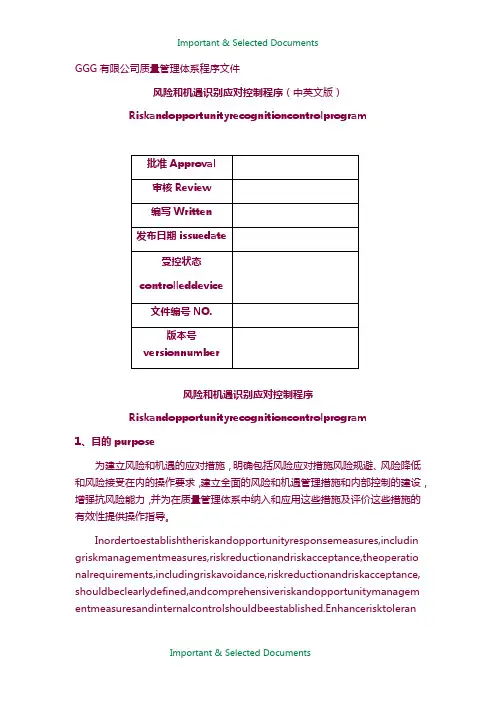
GGG有限公司质量管理体系程序文件风险和机遇识别应对控制程序(中英文版)Riskandopportunityrecognitioncontrolprogram风险和机遇识别应对控制程序Riskandopportunityrecognitioncontrolprogram1、目的purpose为建立风险和机遇的应对措施,明确包括风险应对措施风险规避、风险降低和风险接受在内的操作要求,建立全面的风险和机遇管理措施和内部控制的建设,增强抗风险能力,并为在质量管理体系中纳入和应用这些措施及评价这些措施的有效性提供操作指导。
Inordertoestablishtheriskandopportunityresponsemeasures,includin griskmanagementmeasures,riskreductionandriskacceptance,theoperatio nalrequirements,includingriskavoidance,riskreductionandriskacceptance, shouldbeclearlydefined,andcomprehensiveriskandopportunitymanagem entmeasuresandinternalcontrolshouldbeestablished.Enhancerisktoleranceandprovideoperationalguidanceforincorporatingandapplyingtheseme asuresandevaluatingtheireffectivenessinthequalitymanagementsystem.2、范围Scope本程序适用于在公司质量管理体系活动中应对风险和机遇的方法及要求的控制提供操作依据,这些活动包括:Thisprocedureappliestothecontrolofmethodsandrequirementstoadd ressrisksandopportunitiesinthequalitymanagementsystemactivitiesofthe company.Theseactivitiesinclude:1)业务开发、市场调查及客户满意度测评过程的风险和机遇管理;Riskandopportunitymanagementinbusinessdevelopment,marketresearc handcustomersatisfactionassessmentprocess;2)产品的设计开发、设计开发的变更控制过程的风险和机遇管理;Productdesignanddevelopment,designanddevelopmentofchangecontrol processriskandopportunitymanagement;3)供应商评审和采购控制过程的风险和机遇管理;Riskandopportunitymanagementofsupplierreviewandprocurementcontr olprocess;4)生产过程的风险和机遇管理;Riskandopportunitymanagementintheprocessofproduction;5)过程检验和监视测量设备的管理过程的风险和机遇管理;Processinspectionandmonitoringmeasurementequipmentmanagementp rocessriskandopportunitymanagement;6)设备和工装夹具的维护和保养管理过程的风险和机遇管理;RiskandopportunitymanagementofequipmentandfiGturemaintenancean dmaintenanceprocess;7)不合格品的处置及纠正预防措施的执行和验证过程的风险和机遇管理;Managementofrisksandopportunitiesinthehandlingofnonconformingpro ductsandtheimplementationofcorrectiveandpreventiveactionsandverific ationprocess;8)持续改进过程的风险和机遇管理;Riskandopportunitymanagementofcontinuousimprovementprocess;9)当适用时,也可适用于对公司管理过程中应对风险和机遇的控制提供操作指南。
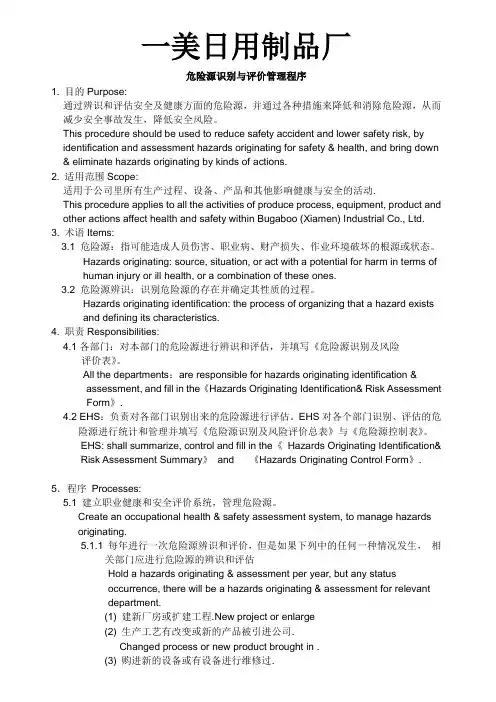
一美日用制品厂危险源识别与评价管理程序1. 目的Purpose:通过辨识和评估安全及健康方面的危险源,并通过各种措施来降低和消除危险源,从而减少安全事故发生,降低安全风险。
This procedure should be used to reduce safety accident and lower safety risk, by identification and assessment hazards originating for safety & health, and bring down & eliminate hazards originating by kinds of actions.2. 适用范围Scope:适用于公司里所有生产过程、设备、产品和其他影响健康与安全的活动.This procedure applies to all the activities of produce process, equipment, product and other actions affect health and safety within Bugaboo (Xiamen) Industrial Co., Ltd. 3. 术语Items:3.1 危险源:指可能造成人员伤害、职业病、财产损失、作业环境破坏的根源或状态。
Hazards originating: source, situation, or act with a potential for harm in terms of human injury or ill health, or a combination of these ones.3.2 危险源辨识:识别危险源的存在并确定其性质的过程。
Hazards originating identification: the process of organizing that a hazard exists and defining its characteristics.4. 职责Responsibilities:4.1各部门:对本部门的危险源进行辨识和评估,并填写《危险源识别及风险评价表》。
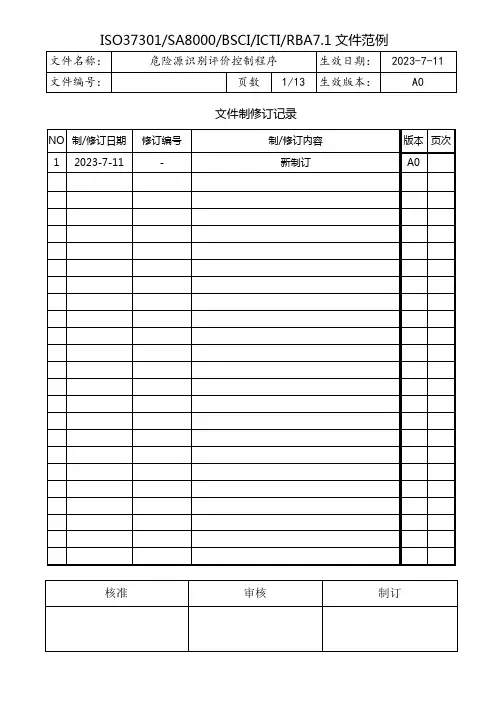
文件制修订记录危险源识别和评价控制程序Hazard identification and evaluation control procedures1、目的Purpose对公司范围内存在的危险源进行辨识与评价,制定风险控制措施,并对其实施控制,以减少或避免不期望的事件发生,保证安全生产。
Identify and evaluate existed hazards in the company, prepare risk control measures and control them to reduce or avoid undesirable incidents,to ensure safety in production.2、适用范围Scope本程序适用于公司范围内的生产活动、服务过程中的安全评价与控制。
This procedure applies to the safety evaluation and control of company's production activities and service process.3、职责Responsibilities3.1各部门:负责制定《危险源识别及风险评价表》及《危险岗位清册》3.1 All Departments: responsible for preparing "hazard identification and risk assessment form"and "dangerous job list".3.2 行政部:3.2 Administration Department:3.2.1组织危险源辨别,将各部门《危险辨别及风险评价表》汇总。
3.2.1Identify hazard, summarize each department’s"hazard identification and riskassessment form".3.2.2进行环境因素评价,制订公司《危险辨别及风险评价表》。
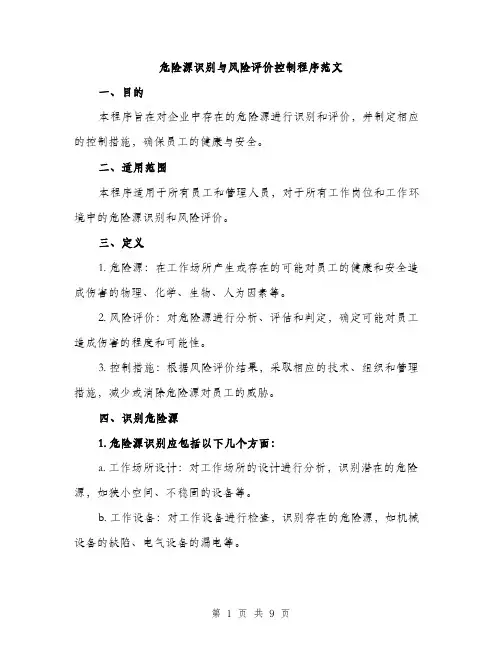
危险源识别与风险评价控制程序范文一、目的本程序旨在对企业中存在的危险源进行识别和评价,并制定相应的控制措施,确保员工的健康与安全。
二、适用范围本程序适用于所有员工和管理人员,对于所有工作岗位和工作环境中的危险源识别和风险评价。
三、定义1. 危险源:在工作场所产生或存在的可能对员工的健康和安全造成伤害的物理、化学、生物、人为因素等。
2. 风险评价:对危险源进行分析、评估和判定,确定可能对员工造成伤害的程度和可能性。
3. 控制措施:根据风险评价结果,采取相应的技术、组织和管理措施,减少或消除危险源对员工的威胁。
四、识别危险源1. 危险源识别应包括以下几个方面:a. 工作场所设计:对工作场所的设计进行分析,识别潜在的危险源,如狭小空间、不稳固的设备等。
b. 工作设备:对工作设备进行检查,识别存在的危险源,如机械设备的缺陷、电气设备的漏电等。
c. 物质和化学品:对企业使用的物质和化学品进行审查,识别可能存在的危险源,如有害物质的泄漏、易燃物品的存放等。
d. 作业环境:对作业环境进行评估,识别可能的危险源,如高温、高湿度、噪音等。
2. 危险源识别应由企业的安全管理人员以及相关部门共同组成识别小组进行。
3. 危险源识别应定期进行,并记录识别结果。
五、风险评价1. 风险评价包括对危险源的分析、评估和判定,确定可能对员工造成伤害的程度和可能性。
2. 风险评价应根据危险源的性质和特点进行分类,并制定风险评价表格进行评估。
3. 风险评价结果包括风险等级和风险评估报告,将用于后续的控制措施制定。
六、控制措施1. 控制措施的制定应根据风险评价结果,并参考相关法律法规、标准和技术规范。
2. 控制措施可以采取以下几个方面:a. 技术控制:采用技术手段减少或消除危险源,如改进设备、提高工艺等。
b. 组织控制:通过组织安排和管理措施,减少或消除危险源对员工的威胁,如设立警示标识、制定安全操作规程等。
c. 个体控制:员工应采取个体防护措施,如佩戴防护设备、接受培训等。
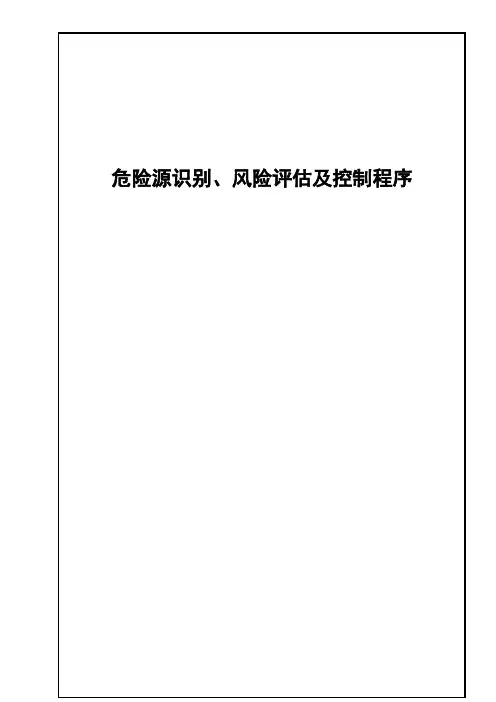
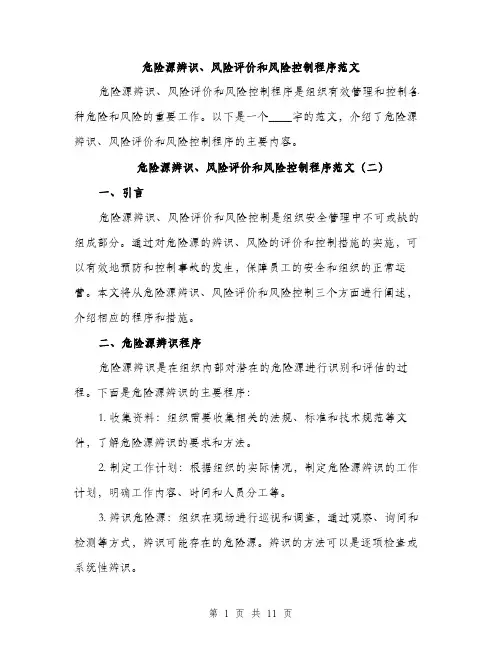
危险源辨识、风险评价和风险控制程序范文危险源辨识、风险评价和风险控制程序是组织有效管理和控制各种危险和风险的重要工作。
以下是一个____字的范文,介绍了危险源辨识、风险评价和风险控制程序的主要内容。
危险源辨识、风险评价和风险控制程序范文(二)一、引言危险源辨识、风险评价和风险控制是组织安全管理中不可或缺的组成部分。
通过对危险源的辨识、风险的评价和控制措施的实施,可以有效地预防和控制事故的发生,保障员工的安全和组织的正常运营。
本文将从危险源辨识、风险评价和风险控制三个方面进行阐述,介绍相应的程序和措施。
二、危险源辨识程序危险源辨识是在组织内部对潜在的危险源进行识别和评估的过程。
下面是危险源辨识的主要程序:1. 收集资料:组织需要收集相关的法规、标准和技术规范等文件,了解危险源辨识的要求和方法。
2. 制定工作计划:根据组织的实际情况,制定危险源辨识的工作计划,明确工作内容、时间和人员分工等。
3. 辨识危险源:组织在现场进行巡视和调查,通过观察、询问和检测等方式,辨识可能存在的危险源。
辨识的方法可以是逐项检查或系统性辨识。
4. 记录和评估:对辨识到的危险源进行记录,并根据危险程度和可能性等因素进行评估。
评估方法可以是定性评估或定量评估。
5. 提出建议:根据评估结果,提出相应的危险源控制建议。
建议可以包括工程控制、安全设备使用、操作规程制定等措施。
6. 审查和改进:对危险源辨识的结果进行审查,了解评估和建议的可行性,并根据需要进行改进和完善。
三、风险评价程序风险评价是对辨识到的危险源的风险进行量化或定性评估的过程。
下面是风险评价的主要程序:1. 收集资料:组织需要收集相关的风险评价方法和指南,了解风险评价的要求和方法。
2. 制定评价计划:根据组织的实际情况,制定风险评价的工作计划,明确评价内容、时间和人员分工等。
3. 量化评价:对风险进行量化评估,主要包括风险的可能性、严重程度和频率等指标的测定。
评价方法可以是事件树分析、故障树分析等。
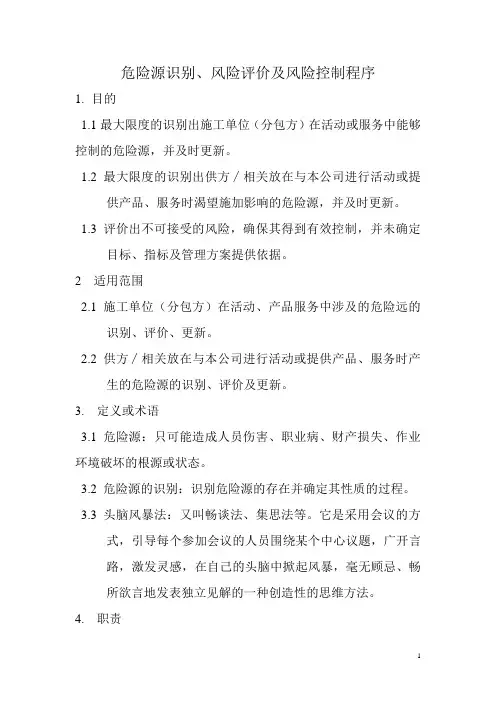
危险源识别、风险评价及风险控制程序1.目的1.1最大限度的识别出施工单位(分包方)在活动或服务中能够控制的危险源,并及时更新。
1.2 最大限度的识别出供方∕相关放在与本公司进行活动或提供产品、服务时渴望施加影响的危险源,并及时更新。
1.3 评价出不可接受的风险,确保其得到有效控制,并未确定目标、指标及管理方案提供依据。
2 适用范围2.1 施工单位(分包方)在活动、产品服务中涉及的危险远的识别、评价、更新。
2.2 供方∕相关放在与本公司进行活动或提供产品、服务时产生的危险源的识别、评价及更新。
3. 定义或术语3.1 危险源:只可能造成人员伤害、职业病、财产损失、作业环境破坏的根源或状态。
3.2 危险源的识别:识别危险源的存在并确定其性质的过程。
3.3 头脑风暴法:又叫畅谈法、集思法等。
它是采用会议的方式,引导每个参加会议的人员围绕某个中心议题,广开言路,激发灵感,在自己的头脑中掀起风暴,毫无顾忌、畅所欲言地发表独立见解的一种创造性的思维方法。
4. 职责4.1 项目部发布《危险源清单》及更新信息。
4.2 施工单位(分包方)负责对各自范围内的危险源进行具体的辨别和评价,确定不可接受的危险源,并进行控制,并向项目部上报本单位危险源更新信息及《不可接受风险清单》。
5. 工作程序5.1 危险源识别5.1.1 危险源的分类5.1.2 危险源辩识的范围a. 施工单位(分包方)工作场所内的常规和非常规的活动,如:施工过程、办公室水磨石地面墩地(有滑倒的危险)等;b. 所有进入工作场所的人员(包括合同房、供应方人员和参访者)的活动。
c. 工作场所的设施(无论由本公司还是由外界所提供)。
5.1.3 危险源的识别a. 询问和交流b. 现场观察c. 查阅有关记录d. 获取外部信息e. 工作任务分析f. 安全检查表g. 作业条件危险性评价5.2. 危险源识别的分工5.2.1. 项目部在以往体系运行识别控制的基础上,发布《危险源清单》。
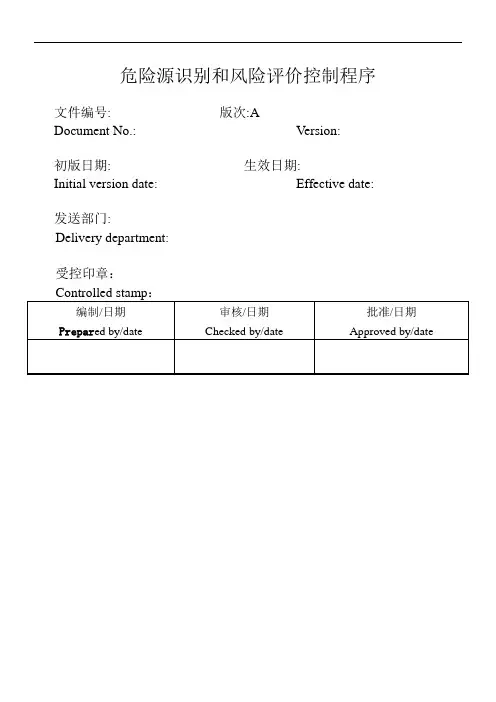
危险源识别和风险评价控制程序文件编号: 版次:ADocument No.: Version:初版日期: 生效日期:Initial version date: Effective date:发送部门:Delivery department:受控印章:Controlled stamp:编制/日期Prepar ed by/date审核/日期Checked by/date批准/日期Approved by/date标题危险源识别和风险评价控制程序版次 A文件修改履历Modification Records版本Versio n 章节号Chapter No.修改内容Modification content修改日期Modification date修改人Mender标题危险源识别和风险评价控制程序版次 A1.目的:为了全面的辨识出公司的危险源,并对其进行评价以确定重要危险源,从而采取措施加以控制。
2.适用范围:适用于公司对危险源的辨识、评价以及采取相应措施的工作。
3.定义:3.1危险源:可能导致伤害和疾病、财产损失、工作环境破坏或这些情况组合的根源或状态。
3.2重要危险源:指超出可容许风险的危险源。
3.3风险:某一特定危险情况发生的可能性和后果的组合。
3.4可容许风险:根据组织的法律义务和职业健康安全方针,已降至组织可接受程度的风险。
4.职责分配:4.1 各部门负责对本部门的危险源进行识别和风险评价,填写《危险源识别表》EHSP-03-F2和《危险源评价表》EHSP-03-F3。
4.2 品质部根据各部门的《危险源评价表》EHSP-03-F3,汇总整理成本公司的《重要危险源清单》EHSP-03-F1。
4.3 总经理负责批准《重要危险源清单》EHSP-03-F1并召集相关部门制定控制措施。
5.流程图:流程图责任部门相关表单2.危险源的辨识4.重要危险源确认5.重要危险源的控制6.危险源的新增变更1.各部门2.各部门3.各部门 3.《危险源识别表》《危险源评价表》4.总经理、品质部 4.《重要危险源清单》5.各部门6.各部门2.《危险源识别表》6.《危险源识别表》《危险源评价表》《重要危险源清单》1.资料收集3.风险评价1.无5.无标题危险源识别和风险评价控制程序版次 A6. 程序内容:6.1资料收集:各部门在危险源辨识活动展开前,先收集相关资料,以便于辨识工作的开展.包括:6.1.1 本部门的地理位置、平面图,周围的危险敏感点。
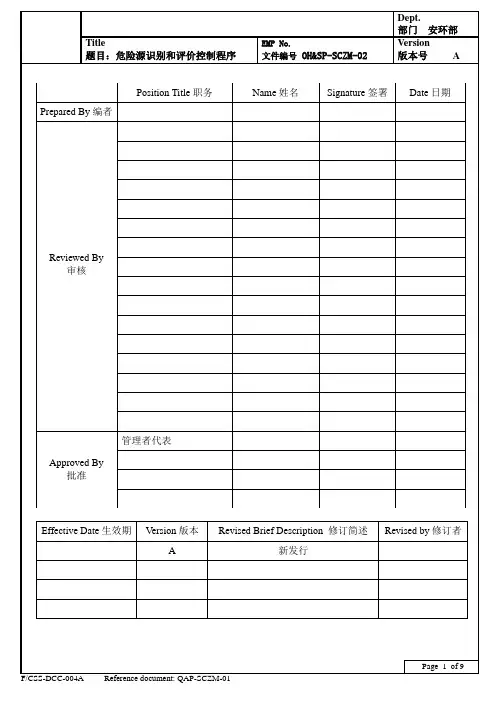
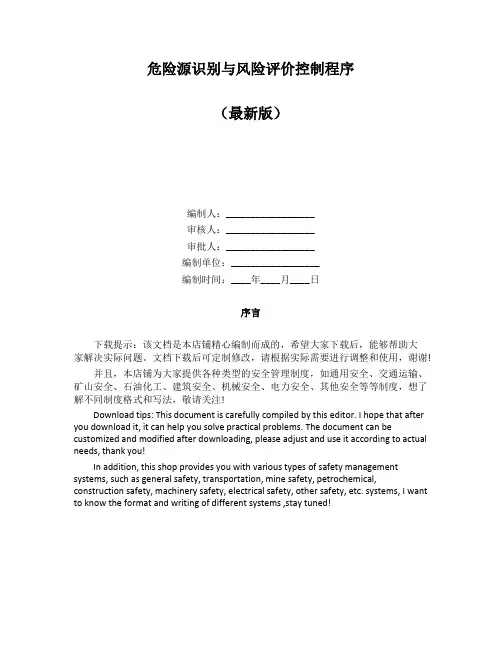
危险源识别与风险评价控制程序(最新版)编制人:__________________审核人:__________________审批人:__________________编制单位:__________________编制时间:____年____月____日序言下载提示:该文档是本店铺精心编制而成的,希望大家下载后,能够帮助大家解决实际问题。
文档下载后可定制修改,请根据实际需要进行调整和使用,谢谢!并且,本店铺为大家提供各种类型的安全管理制度,如通用安全、交通运输、矿山安全、石油化工、建筑安全、机械安全、电力安全、其他安全等等制度,想了解不同制度格式和写法,敬请关注!Download tips: This document is carefully compiled by this editor. I hope that after you download it, it can help you solve practical problems. The document can be customized and modified after downloading, please adjust and use it according to actual needs, thank you!In addition, this shop provides you with various types of safety management systems, such as general safety, transportation, mine safety, petrochemical, construction safety, machinery safety, electrical safety, other safety, etc. systems, I want to know the format and writing of different systems ,stay tuned!危险源识别与风险评价控制程序1 目的对生产安全危险源进行识别,并评价其危险程度,为制定生产安全目标、专项生产方案、运行控制措施、应急准备措施提供重要依据,保障生产安全的顺利实施。
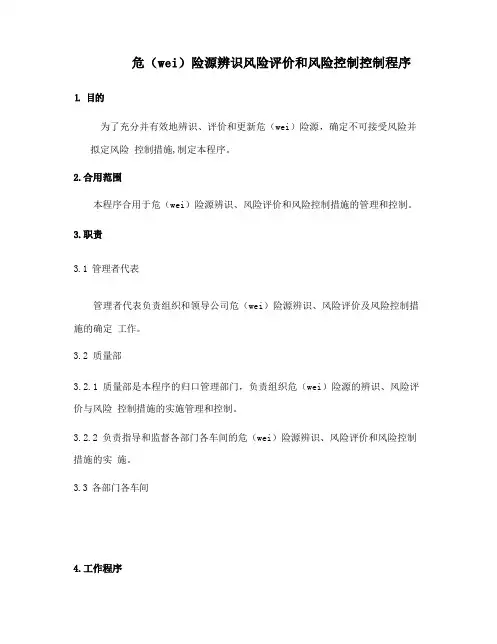
为了充分并有效地辨识、评价和更新危(wei)险源,确定不可接受风险并拟定风险控制措施,制定本程序。
本程序合用于危(wei)险源辨识、风险评价和风险控制措施的管理和控制。
3.1 管理者代表管理者代表负责组织和领导公司危(wei)险源辨识、风险评价及风险控制措施的确定工作。
3.2 质量部3.2.1 质量部是本程序的归口管理部门,负责组织危(wei)险源的辨识、风险评价与风险控制措施的实施管理和控制。
3.2.2 负责指导和监督各部门各车间的危(wei)险源辨识、风险评价和风险控制措施的实施。
3.3 各部门各车间负责组织本部门/车间管辖范围内的危(wei)险源辨识、风险评价工作,负责填写《危(wei)险源辨识与风险评价表》,并负责对本单位的危(wei)险源实施管理和控制。
管理者代表根据危(wei)险源辨识、风险评价和风险控制措施的需要,组建危(wei)险源辨识、风险评价领导小组,全面指导危(wei)险源辨识、风险评价工作。
各部门各车间成立危(wei)险源辨识、风险评价工作小组,成员应接受过相关知识的培训。
各部门各车间工作小组对作业活动中存在的危(wei)险源进行全面辨识,并进行风险评价;危(wei)险源辨识、风险评价必须客观、真实,反映事物的客观属性,填写《危(wei)险源辨识风险评价表》报质量部。
质量部对各部门各车间上报的危(wei)险源辨识、风险评价结果进行分析、整合、汇总,形成公司级《危(wei)险源辨识风险评价表》和《不可接受风险及控制措施汇总表》报管理者代表审批。
4.5.1 根据 GB/T13861 《生产过程危(wei)险和有害因素分类与代码》将生产过程中的危险和有害因素分为 6 大类。
4.5.2 按GB/T6441 《企业职工伤亡事故分类》,综合考虑起因物、引起事故的诱导性原因、致害物、伤害方式等,将危(wei)险因素分为 20 类。
4.5.3 依据《职业病目录》综合考虑职业活动中存在的各种有害的化学、物理、生物因素以及在作业过程中产生的其他职业病有害因素将职业病分为 10 大类。
危险源识别及风险评价控制程序Hazard source identification and risk evaluation control procedure(ISO45001:2017)1.目的Purpose:对本公司能够控制和可望施加影响的危险因素进行辨识和评价,并从中评价出重要危害因素,为建立职业健康安全目标指标﹐实施运行控制和改善安全卫生行为提供依据。
To identify and evaluate the controllable and excepted and influenced hazard aspects, identify the important hazard aspect, provide the reference for the establishment of the occupational health and safety objectives and the implementation of the operational control and the improvement of safety and health behavior.2.适用范围Application scope:本程序适用于公司产品、活动及服务等危害辨识和危险评价。
It is applicable to the hazard identification and evaluation for the company’s products, activities, services and etc..3.定义Definition:无N/A4.职责Responsibility:4.1 各部门:负责辨识和评价本部门的危害因素。
4.1 Each Department: To identify and evaluate the hazard aspect within the department.4.2 人力资源部:负责辨识和评价相关方的危害因素及危险因素的汇总﹑审核﹐组织评价和确定重要危险因素﹑各部门协助。
4.2 Human Resources dept. : To summarize and review the identification and evaluation of the related hazard aspect and risk aspect and organize to evaluate and define the important risk aspect, coordinate with each dept..4.3 管理者代表:负责重要危害因素评价结果的审批。
4.3 Management Representative: To approve the result of the important risk aspect evaluation.5.程序Operational procedure:5.1危害因素的辨识与风险评价Risk aspect identification and risk evaluation5.1.1危害因素的辨识与评价范围分两大部分:5.1.1 The scope of the risk aspect identification and evaluation including two parts: 5.1.1.1 公司内部:即公司各部门自身的日常活动及有行政管理活动范围。
5.1.1.1 Internal of the company: The daily activities of the company's various departments and administrative activities.5.1.1.2 相关方:即公司对行政管辖区域内建筑施工或供货商等可施加影响的活动﹑产品﹑服务范围。
5.1.1.2 The related parties: the activities, products and services scope can be affected by the construction or suppliers etc. within the administrative jurisdiction of the company .5.1.2 各部门首先应按照本程序的内容和要求,分别识别出内部自身的和对口业务相关方的能够控制和可施加影响的危害因素,并加以判断﹐评价出具有重大危害影响或可能具有重大危害影响的因素。
辨识和评价的结果应分别填写在《危害辨识与风险评价清单》上﹐经部门负责人审核确认后上交人力资源部。
5.1.2 Firstly each department, based on the content and requirements of this procedure, separately identify the hazard factors from their own and interface business related parties can control and give the influence and to judge and determine the factors with significant impacts or possible have significant impact; the identific ation and evaluation results should be separately filled in the “hazard identification and risk evaluation list”, and provided to human resources department after checked by the department responsible staff.5.1.3 安全主任对各部门上交的结果进行复核,必要时加以补充,将最终整理出的结果填写《危害辨识与风险评价清单》,交管理者代表审核。
5.1.3 Safety Officers re-check the results from each department, if necessary, provide some supplement; and finalize the results in the “hazard identification and risk evaluation list” to m anagement representative for approval;5.1.4 各部门将本部门确认后的危害辨识及风险评价清单留存一份,向本部门的员工进行宣传,以便明确本部门的危害因素对其加以控制和施加影响。
5.1.4 Each department should keep one copy of the confirmed hazard identification and risk evaluation list and publicize it to their employees to clarify the department's hazard factors and then control and affect them;5.1.5 危害辨识与风险评价工作每年进行一次,由人力资源部组织进行。
5.1.5 Hazard Identification and risk evaluation should be organized by human resource department and conducted once per year;5.1.6 各部门在发生以下情况时应重新辨识与评价危害因素,及时更新:5.1.6 each department should re-identify and re-evaluate the hazard factors and update it timely for the following cases:5.1.6.1 管理体系或产品、活动及服务发生重大变化(增加或减少)。
5.1.6.1 significant change(increase or decrease) for the management system or products , activities and services.5.1.6.2 有关的安全法律、法规修订或废止。
5.1.6.2 the relevant safety legal and regulatory are amended or repealed.5.1.6.3 本公司的发展规划作调整或开发建设发生较大变化。
5.1.6.3 adjust the company’s development plan or bigger change for the development and construction5.1.6.4 定期测量结果发生变化。
5.1.6.4 results change for the periodical measurement;5.1.6.5 材料、设施或设备发生变更。
5.1.6.5 materials, facilities or equipment change5.1.6.6 发生了紧急情况或安全事故。
5.1.6.6 undergone emergency or security incidents.5.1.6.7 相关方有建议或抱怨。
5.1.6.7 suggestion or complaint from the related parties;5.1.6.8 重新辨识和评价危害因素的程序按5.1.1﹑5.1.2﹑5.1.3﹑5.1.4款进行。
5.1.6.8 re- identification and evaluation of risk factors according to the clause 5.1.1,5.1.2,5.1.3,5.1.4;5.2 在进行危害因素评价时应考虑以下方法:各部门负责人对各自辨识出的危害因素逐一进行评价,评价时可采用是非判断法﹑作业条件危险评价法进行。
5.2 When conduct the risk factors evaluation, should consider the following methods: each department responsible staff should evaluate their own identified risk factors one by one, can use the yes-no judgment method and operation condition risk evaluation method for implementation;5.2.1 是非判断法。